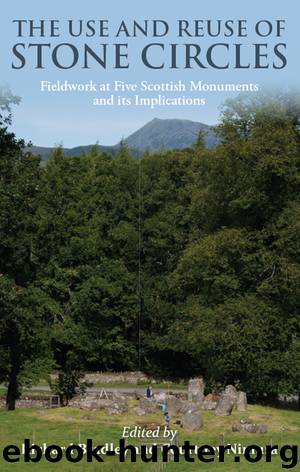The Use and Reuse of Stone Circles by Richard Bradley & Courtney Nimura

Author:Richard Bradley & Courtney Nimura
Language: eng
Format: epub
Publisher: Casemate Publishers & Book Distributors, LLC
Published: 2017-07-15T00:00:00+00:00
Figure 5.13. Excavated pits in the interior of the enclosure at Tuach (Aaron Watson).
Figure 5.14. (above) Urn 4 on its discovery, and (below) Urn 5 showing the cap of redeposited clay over the inverted vessel. Both had been disturbed during the 1855 excavation (Richard Bradley).
Cremation burials
Two burials were discovered in the 2011 excavation (Fig. 5.14). One was in an inverted Collared Urn (Urn 4) which had been buried in a steep-sided pit (Feature 4). It was tightly packed in the ground and surrounded by series of pebbles derived from the local drift. Its base was missing and may have been removed in the course of Dalrymple’s excavation. The vessel contained the cremated remains of a young adult, probably a man. Unlike two of the urns encountered in 1855, it was not supported on a granite slab, but five smaller pieces of granite had been placed beneath its rim. Because it had been cut by the Victorian excavation it is not known whether this deposit had been covered by a stone.
The second burial was in a cylindrical pit (Feature 5), one edge of which had been cut by a trench excavated in 1855. It was in an inverted Cordoned Urn (Urn 5) which had been placed on a thin layer of charcoal. The top of this feature was sealed by a plug of clay indistinguishable from the surrounding subsoil; it is obvious that the position of the burial had been concealed. Again there was no evidence that the urn had been supported on a slab. It contained the cremated bones of an adult who was over 30 years old. It was not clear from the bones themselves whether this burial was male or female. A bronze object, identified below as a razor, had been added to its contents before the vessel was buried and was located just inside the rim. Surviving residues suggest that it was originally inside a sheath made of animal hide. Examination of the metal fragments by Dr Peter Northover (pers. comm.) confirmed the impression, given by the presence of the sheath, that this artefact had not passed through the pyre. The presence of this artefact – a type of object invariably associated with males – strongly suggests that the burial was of a man. One feature that connects both burials is that red pebbles derived from the local drift had been placed in and around the inverted pots. By contrast, all the monoliths at Tuach seem to have been grey or white.
Download
This site does not store any files on its server. We only index and link to content provided by other sites. Please contact the content providers to delete copyright contents if any and email us, we'll remove relevant links or contents immediately.
The Daily Stoic by Holiday Ryan & Hanselman Stephen(3194)
The Fate of Rome: Climate, Disease, and the End of an Empire (The Princeton History of the Ancient World) by Kyle Harper(2975)
People of the Earth: An Introduction to World Prehistory by Dr. Brian Fagan & Nadia Durrani(2673)
Ancient Worlds by Michael Scott(2576)
Babylon's Ark by Lawrence Anthony(2488)
The Daily Stoic by Ryan Holiday & Stephen Hanselman(2423)
Foreign Devils on the Silk Road: The Search for the Lost Treasures of Central Asia by Peter Hopkirk(2407)
India's Ancient Past by R.S. Sharma(2367)
MOSES THE EGYPTIAN by Jan Assmann(2347)
The Complete Dead Sea Scrolls in English (7th Edition) (Penguin Classics) by Geza Vermes(2203)
Lost Technologies of Ancient Egypt by Christopher Dunn(2172)
The Earth Chronicles Handbook by Zecharia Sitchin(2149)
24 Hours in Ancient Rome by Philip Matyszak(2025)
Alexander the Great by Philip Freeman(2009)
Aztec by Gary Jennings(1929)
The Nine Waves of Creation by Carl Johan Calleman(1841)
Curse Tablets and Binding Spells from the Ancient World by Gager John G.;(1817)
Before Atlantis by Frank Joseph(1787)
Earthmare: The Lost Book of Wars by Cergat(1762)
